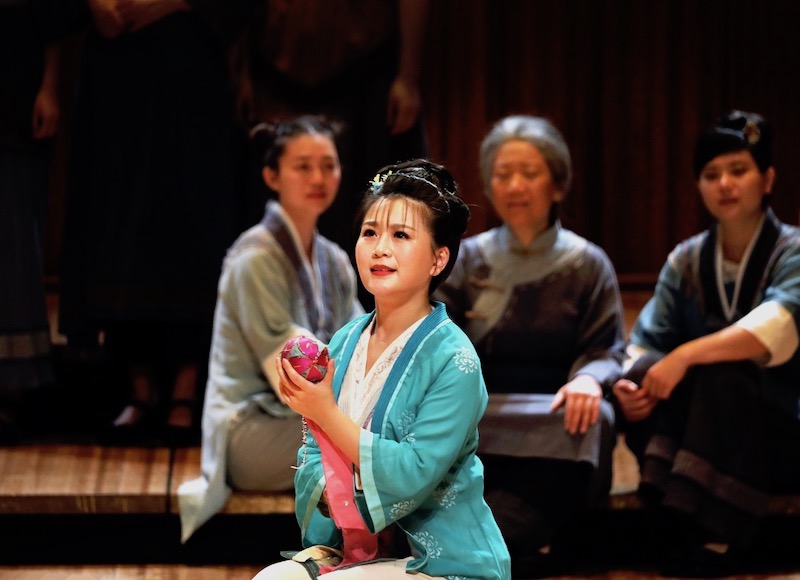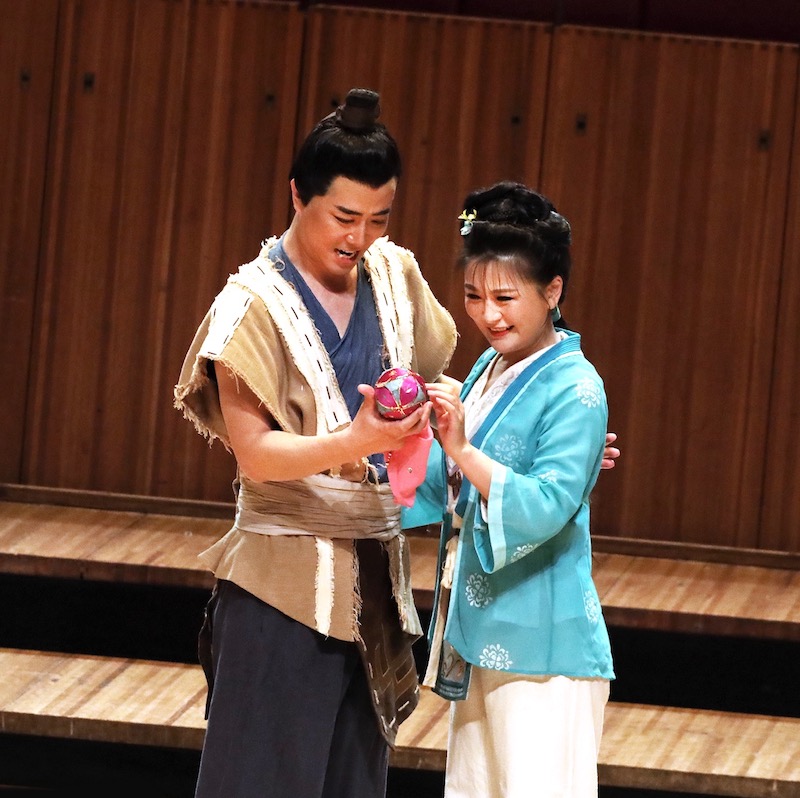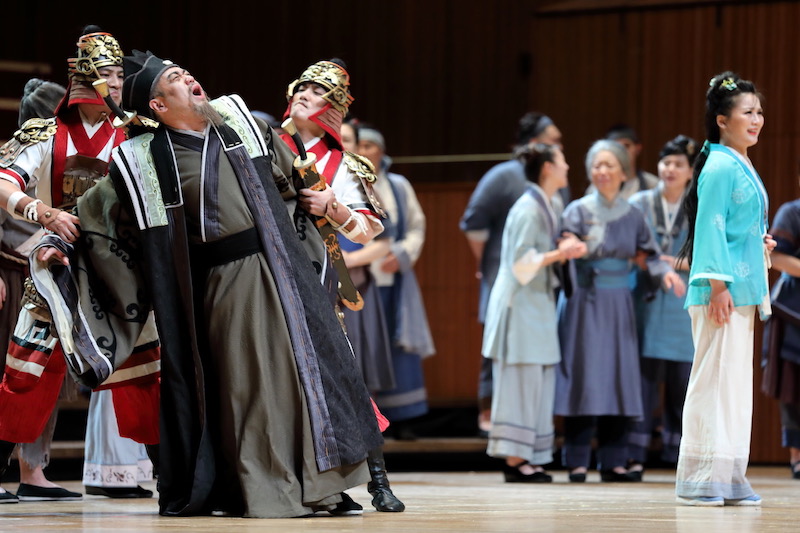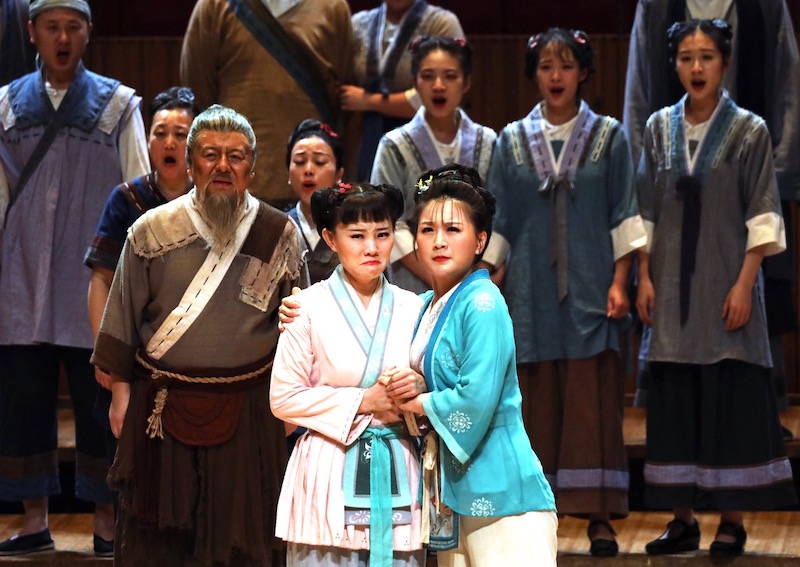We hear the voice of Liu Sanjie from the wings first. The legendary folk singer is an iconic figure in the storytelling of the Zhuang people, the largest minority in China, who mostly live in the Guangxi Zhuang Autonomous Region in southern China. Known as the Song Fairy, her voice immediately lifts the spirits of the Zhuang villagers depicted on stage. From her first appearance, Liu Sanjie, played here by Jiang Ning, is a shining beacon of hope, almost always smiling no matter what happens around her until the dramatic events at the end of the opera.
 Jiang Ning. Photograph © Jiang Changgeng
Jiang Ning. Photograph © Jiang Changgeng
The story of Liu Sanjie has been adapted many times over the years, becoming particularly famous thanks to the popular 1961 musical film Liu Sanjie (or the Third Sister Liu), which featured a number of Chinese folk songs. In July last year, an opera called Liu Sanjie based on that film premiered at the Beijing National Centre for Performing Arts. Written by female classical Chinese composer Lei Lei, a concert version of the opera is now being presented in Australia by Ausfeng Event Productions. Entitled Legend of the Chinese Song Fairy, Opera Lie Sanjie in Concert, it is the first time the show has been seen outside China.
Lei Lei has written other Chinese language western-style operas including Xi Shi (2009) named after one of the Four Beauties of ancient China, The Chinese Orphan (2011) based on the story of The Orphan of Zhao, and Visitor on the Icy Mountain (2015) based on the 1963 film of the same name.
Legend of the Chinese Song Fairy, which features a libretto by Yi Ming, combines some of the famous folk songs from the film including Only Folk Songs together with western-style arias, duets and choral numbers. There are also dialogue scenes.
 Wu Pan and Jiang Ning. Photograph © Jiang Changgeng
Wu Pan and Jiang Ning. Photograph © Jiang Changgeng
The simple plot, which gives us broad-brush characters and a lightweight narrative, deals with issues around oppression, corruption, love, bravery and the fight for equality. We meet Liu Sanjie as she is sailing her bamboo raft down the river where she meets the Prince of Jingjang and his daughter. When her beautiful singing voice is heard by the Zhang villagers, who live on the river, they beg her to stay with them and she accepts the invitation, joining the family of the handsome A-niu, his father and his sister Zhou-mei who work on the villagers’ tea plantation. When the corrupt landlord Mo Huairen tries to seize the plantation, Liu Sanjie challenges him to a singing competition. Mo enlists three scholars to compete with her, but she easily defeats them.
A-niu and Liu Sanjje secretly fall in love but Mo wants her for himself and has her captured. When A-niu tries to rescue her, he is discovered, tied up and thrown into the river. The Prince and the Little Princess rescue Liu Sanjie and offer her a home at their palace, but she decides to carry on down the river searching for her lost lover A-niu.
 Ren Hanfu, Jiang Ning and company. Photograph © Jiang Changgeng
Ren Hanfu, Jiang Ning and company. Photograph © Jiang Changgeng
The production in Australia is a touring concert version. The cast of nearly 60 performers, including a 40-strong chorus, wear costumes – grey, blue and brown clothes for the chorus, and more detailed, vividly coloured outfits for the principal and featured characters – but there is no set, with the company performing on a bare stage with well-positioned surtitles. They are accompanied by Biyan Duan on piano, with conductor Dawei Li standing next to her to the left of the stage.
Running 100 minutes without interval, the concert features five acts which are separated by short blackouts. The Song Fairy is known for giving a voice to the impoverished through her mountain songs, and for expressing her yearning for love. Here she emerges as the most quick-thinking of all, outsmarting those around her as she stands up against corruption and fights for equality, while drawing on the wealth and beauty of nature in the analogies she uses. She doesn’t hold back either; the lyrics have her boldly standing her ground and dishing it out – “You’re a two-faced Janus, a duplicitous bloke” she says to Mo, for example.
 Yang Yue and Jiang Ning. Photograph © Jiang Changgeng
Yang Yue and Jiang Ning. Photograph © Jiang Changgeng
The action sits somewhere between naturalism and stylisation, so feels rather melodramatic and unconvincing at times, particularly the fight scenes, but there is some engaging music and singing.
Jiang Ning uses Chinese folk style vocal characterisations and delicate ornamentation in her singing, drawing huge applause from the audience at the end of the show, while Wu Pan has a rich, golden tenor voice, and sings with great clarity, warmth and expression. Qian Zhiguo brings a darker, dramatic baritone to the role of A-niu’s father, Ren Hanfu is suitably malevolent as Mo Huairen, and there are dainty vocal performances from Yang Yue as A-niu’s sister Zhou-mei and Wang Jiayun as the Little Princess.
There is some lovely music for the chorus, from wafting phrases and lilting harmonies to soaring emotional crescendos, all beautifully sung by the 40-strong ensemble.
Legend of the Chinese Song Fairy plays at Arts Centre Melbourne on Tuesday December 17











Comments
Log in to join the conversation.